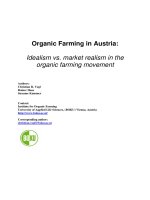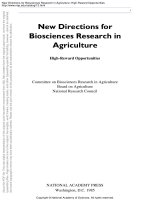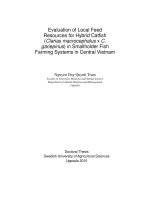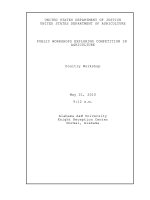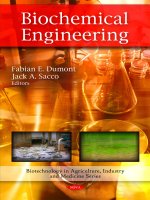IoT in agriculture smart farming
Bạn đang xem bản rút gọn của tài liệu. Xem và tải ngay bản đầy đủ của tài liệu tại đây (267.45 KB, 5 trang )
See discussions, stats, and author profiles for this publication at: />
IoT in Agriculture : Smart Farming
Article in International Journal of Scientific Research in Computer Science Engineering and Information Technology · December 2018
DOI: 10.32628/CSEIT183856
CITATIONS
READS
31
5,447
1 author:
Kanchana Sivanraju
PSG College of Arts and Science
15 PUBLICATIONS 59 CITATIONS
SEE PROFILE
All content following this page was uploaded by Kanchana Sivanraju on 02 May 2021.
The user has requested enhancement of the downloaded file.
International Journal of Scientific Research in Computer Science, Engineering and Information Technology
© 2018 IJSRCSEIT | Volume 3 | Issue 8 | ISSN : 2456-3307
DOI : />
IoT in Agriculture : Smart Farming
Dr. S. Kanchana
Assistant Professor, Department of Computer Science, PSG College of Arts and Science, Coimbatore, Tamil
Nadu, India
ABSTRACT
From farm to fork, information and communication technology sector is being enhanced to facilitate the
farmers, croppers and related users of intelligent services. Technological revolution integrates the development
of smart devices and IoT services. To feed the ever growing global population, the agriculture industry needs to
be extended. Internet of Things opens the door wide for smart farming solution to increase the agricultural
production. IoT technologies helps the farmers as a service by providing historical and real time data for
predicting soil quality, weather conditions and crop’s health. Smart farming provides the enhanced facility for
process automation and evaluation and waste reduction. As a result, all these factors drastically increase the
quality and quantity of the food products and decrease the production cost. This paper outlines the promising
solutions applied in the sphere of agriculture.
Keywords : Smart Farming, Internet of Things, Green House, IoT agriculture.
I.
INTRODUCTION
network, user can access information from these
devices.
Internet of Things is a dynamic global information
network, supports several applications for users such
Gateway nodes provide on-demand delivery of data
as healthcare organizations, security, smart transports,
or information for high computational processing.
traffic management, E-payment, smart farming etc[1].
The application areas of IoT infrastructure will be
Researchers estimate that IoT will consist of 50
billion objects by 2020[2]. Most of the organizations
extended from smart devices to smart homes and
smart city development [4]. Access control, identity
can be monitored and controlled by smart IoT
management, legal and technical issues are key
devices and applications.
considerations for ensuring security. Deploying
security in IoT is one of the greatest challenges in this
IoT is a future networking paradigm which
interconnected world.
interconnects physically distributed physical and
logical resources. IoT environment consists of four
In agricultural industry, technological advancements
primary components such as things, mobile devices
lead the comfortable pathway for the farmers.
or back end devices, Gateway node and Internet. The
Internet of Things is the driving force behind
things are the devices which may be sensors,
agricultural production at a lower cost in smarter way.
actuators, RFID, mobile devices and smart appliances.
Smart farming technologies can remotely detect soil
Remote users can access these devices and smart
quality, weather conditions, crop growth, and crop
applications by connecting with sensing devices in an
damage using wireless monitoring sensors with cloud
unattended environment [3]. Once connected with
based platform.
CSEIT183856 | Received : 16 Nov 2018 | Accepted : 05 Dec 2018 | November-December-2018 [ 3 (8) : 181-184 ]
181
Dr. S. Kanchana et al. Int J S Res CSE & IT. 2018 November-December-2018; 3(8) : 181-184
In this article, section II describes the review of
III. IOT APPLICATIONS IN AGRICULTURE
existing technologies. Section III enumerates the IoT
applications in agriculture. Section IV is regretted for
Smart farming practices provides the solutions to
challenges in smart farming by farmers. Section V is
overcome the challenges such as rising climate
concluded with future work and it is followed by the
changes, weather conditions, soil conditions, waste
list of references reviewed for designing this article.
reduction and green housing. The Internet of things
are various sensors, autonomous vehicles, control
II. LITERATURE REVIEW
systems and robotics. At below, these are various
stages of prediction in agriculture from farm to fork.
The newer scenario of decreasing water tables, drying
up of rivers and tanks, unpredictable environment
present an urgent need of proper utilization of water.
To cope up with this use of temperature and moisture
sensor at suitable locations for monitoring of crops
[5]. In smart farming, threshold values of temperature
and soil moisture can be programmed into a
microcontroller-based gateway to control water
quantity. The system is powered by photovoltaic
panels and can have a duplex communication link
based on a cellular Internet interface that allows data
inspection and irrigation scheduling to be
programmed through a web page [6].
The technological development in Wireless Sensor
Networks made it possible to use in monitoring and
control of greenhouse parameter in precision
agriculture [7]. Researchers found that the yield of
agriculture is decreasing day by day. However, use of
technology in the field of agriculture plays important
role in increasing the production as well as in
reducing the extra man power efforts. Some of the
research attempts are done for betterment of farmers
which provides the systems that use technologies
helpful for increasing the agricultural yield. Wireless
Sensor Networks is said to be mature technology and
lot of work has been done for agriculture domain [8,
9]. Use of cloud computing for agriculture sector for
storing details of agriculture information has been
explained in [10].
A. Monitoring climate conditions, soil and plants
Dramatic changes in the climate and natural
disasters seriously affect the plant growth and
agricultural production.. Variety of environmental
conditions can also be collected by many sensors and
stored in integrated and heterogeneous information
and reported by internet of Things.
Sensing soil and nutrients, measurement of moisture,
temperature and electrical conductivity are collected
through sensors and stored in integrated databases.
Based on soil profile, fertilizer level to be determined
and applied.
Farmers and agriculturalists needs to install mobile
applications
and
register
with
cloud
through
MobileApp. Cloud storage consists of all the details of
weather conditions, soil conditions irrigation levels,
plant growth and damage. It also stores details about
farmer, marketing agent details, and agro vendors
and service providers and government schemes for
agriculture sector including bank loans for farmers
and concessions given on seed and/or fertilizers.
Periodical data is collected from soil and
environment sampling through sensors, will be
updated and is used for controlling the smart farms.
Internet of Things plays a vital role for monitoring
the plants for identifying diseases and insects which
are affecting the growth. If the level of pest control
exceeds prescribed range, through sensors alarm and
alerts can be generated to warn the farmers to take
Volume 3, Issue 8, November-December-2018 | http:// ijsrcseit.com
182
Dr. S. Kanchana et al. Int J S Res CSE & IT. 2018 November-December-2018; 3(8) : 181-184
actions. Optimal time for planting crops, controlling
used for water irrigation. All these are connected
the pests and plant diseases and harvesting can also
using IoT cloud server accesses the data and provide
be intimated through and cloud database to the
cost effective solutions to the farmers.
farmers and agriculturists.
IV. CHALLENGES IN SMART FARMING
B. Water Irrigation and Waste Reduction
Controlling water usage for optimal plant growth is
enabled by an Internet of Things to monitor tank
leveling and schedule irrigation timings. It is also
necessary to monitor the unwanted leakages. All
these are accessible through the web and mobile
applications hosted on enterprise cloud.
IoT technologies help the agriculturists and farmers
to reduce generated wastes and enhance productivity.
It is a practice that makes the farming procedure
more controlled and accurate for the growing of
crops. After harvesting, for agriculture storage, silos
and grain elevators are to be monitored for sensing
temperature, pressure, humidity and light levels of
the grains.
C. Livestock monitoring
Farmers and agriculturalists collect information
about the location, health conditions of their cattle
The main challenge in technology diffusion in
agriculture is that land holdings are so small, hurting
long-term productivity growth. All our technologies,
like high yielding seeds, are for irrigated lands,
although 48% of our sown area is dry lands.
According to the Agricultural Census 2016, 80% of
land ownership is of less than 2 hectares and total
cropped area is only 45%. Nearly 90% of farmers are
small and marginal. The average size of a farm is now
just 1.15 hectares. Only 5% farmers operate on land
bigger than 4 hectares. Farmers, who have been able
to pool in their lands to increase their farm size to at
least 100-200 acres have been the early beneficiaries.
By contrast, only 5% of farmers operate on land
parcels larger than 4 hectares.
Often, those exploiting smart technologies aren’t
farmers but large agri-businesses. Some of these tools
and feeding schedule. IoT based sensors are also used
are used by farm-loan companies for risk
management,The industry must overcome increasing
for finding the sick animal in the herd before it
water shortages, limited availability of lands, and
contaminates the rest of the animals, It will
fertility of lands difficult to manage cost. Moreover,
drastically reduce livestock losses and reduce costs by
existing strategies are not enough to overcome the
monitoring them continually and recover the others
challenges. Security challenges in the environment of
small embedded devices must be easy to implement
in the large group.
and cost effective.
D. Smart Greenhouses
V. CONCLUSION AND FUTURE WORK
Modern affordable and healthy green houses are to
be built by using Iot sensors which are solar powered.
The sensors are used for providing information about
IoT technology enhances the existing life style of
agriculturalists and farmers by integrating all the
temperature, pressure, humidity and light levels.
These environmental parameters are monitored by
devices to a digital level in the extensive directions.
sensors and controlled either by control systems or
integrated databases and on demand availability of
by manual intervention. Smart sprinklers are also
information will facilitate the smart farming and
Volume 3, Issue 8, November-December-2018 | http:// ijsrcseit.com
Internet technologies, social networks, secured
183
Dr. S. Kanchana et al. Int J S Res CSE & IT. 2018 November-December-2018; 3(8) : 181-184
global food production. The purpose of Smart
[7].
Dr. V .Vidya Devi,G. Meena Kumari, :Real-
Farming is to increase the quality and quantity of
Time Automation and Monitoring System for
agricultural production by using sensing technology
Modernized Agriculture: ,International Journal
to
of Review and Research in Applied Sciences
make farmers more intelligent and
more
connected. New innovative IoT applications will
address these issues and help in increasing the quality,
and Engineering,Vol3 No.1. PP 7-12, 2013.
[8].
Yongxian Song, Juanli Ma, Xianjin Zhang, Yuan
quantity, sustainability and cost effectiveness of
Feng, :Design of Wireless Sensor Network-
agricultural production. IoT can be leveraged to allow
Based Greenhouse Environment Monitoring
the farmers to evaluate the soil conditions, moisture
and Automatic Control System:, JOURNAL OF
level, livestock feed levels density and level of pest
NETWORKS, VOL. 7, NO. 5, 2012.
control. The model development and implementation
will be focused in future.
[9].
Aqueel-ur-Rehman, Abu Zafar Abbasi, Noman
Islam, Zubair Ahmed Shaikh, :A review of
wireless sensor and networks applications in
VI. REFERENCES
[1].
[2].
agriculture:, Computer Standards & Interfaces
Parwinder Kaur Dhillon, Sheetal Kalta. A
36(2014) 263-270.
[10]. Mitsuyoshi Hori, Eiji Kawashima, Tomihiro
lightweight biometrics based remote user
authentication scheme for IoT services.ournal
Yamazaki, :Application of Cloud Computing to
of Information Security and Applications.2017.
FUJISTU Sci. Tech.J., Vol. 46, No. 4, pp. 446-
R.Gaikwad. Internet of Things(iot): Revolution
454,2010.
Agriculture and Prospects in Other Fields:,
of internet for smart environment: Oracle,
[3].
Tech Rep.2016
Munish
Bhatia,
Sandeep
K.Sood,:
A
comprehensive health assessment framework to
facilitate
IoT-assisted
smart
workouts;
A
predictive healthcare perspective: computers in
industry 02, 0166-3615, 2017, pp-50-66.
[4].
Igor Tomi ci c, Petra Grd, Miroslav Ba ca, :A
review of soft biometrics for IoT:, MIPRO 2018.
[5].
S. R. Nandurkar, V. R. Thool, R. C. Thool,
:Design
and
Development
of
Precision
Agriculture System Using Wireless Sensor
Network:, IEEE International Conference on
Automation, Control, Energy and Systems
(ACES), 2014.
[6].
JoaquínGutiérrez, Juan Francisco Villa-Medina,
Alejandra Nieto-Garibay, and Miguel Ángel
Porta-Gándara, :Automated Irrigation System
Using a Wireless Sensor Network and GPRS
Module:,IEEE
TRANSACTIONS
ON
INSTRUMENTATION AND MEASUREMENT,
0018-9456,2013
Volume 3, Issue 8, November-December-2018 | http:// ijsrcseit.com
View publication stats
184


